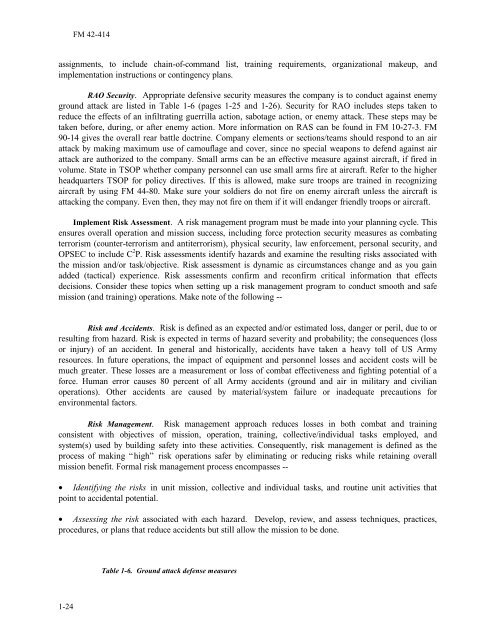Tactics, techniques, and procedures for - Army Electronic ...
Tactics, techniques, and procedures for - Army Electronic ...
Tactics, techniques, and procedures for - Army Electronic ...
Create successful ePaper yourself
Turn your PDF publications into a flip-book with our unique Google optimized e-Paper software.
1-24<br />
FM 42-414<br />
assignments, to include chain-of-comm<strong>and</strong> list, training requirements, organizational makeup, <strong>and</strong><br />
implementation instructions or contingency plans.<br />
RAO Security. Appropriate defensive security measures the company is to conduct against enemy<br />
ground attack are listed in Table 1-6 (pages 1-25 <strong>and</strong> 1-26). Security <strong>for</strong> RAO includes steps taken to<br />
reduce the effects of an infiltrating guerrilla action, sabotage action, or enemy attack. These steps may be<br />
taken be<strong>for</strong>e, during, or after enemy action. More in<strong>for</strong>mation on RAS can be found in FM 10-27-3. FM<br />
90-14 gives the overall rear battle doctrine. Company elements or sections/teams should respond to an air<br />
attack by making maximum use of camouflage <strong>and</strong> cover, since no special weapons to defend against air<br />
attack are authorized to the company. Small arms can be an effective measure against aircraft, if fired in<br />
volume. State in TSOP whether company personnel can use small arms fire at aircraft. Refer to the higher<br />
headquarters TSOP <strong>for</strong> policy directives. If this is allowed, make sure troops are trained in recognizing<br />
aircraft by using FM 44-80. Make sure your soldiers do not fire on enemy aircraft unless the aircraft is<br />
attacking the company. Even then, they may not fire on them if it will endanger friendly troops or aircraft.<br />
Implement Risk Assessment. A risk management program must be made into your planning cycle. This<br />
ensures overall operation <strong>and</strong> mission success, including <strong>for</strong>ce protection security measures as combating<br />
terrorism (counter-terrorism <strong>and</strong> antiterrorism), physical security, law en<strong>for</strong>cement, personal security, <strong>and</strong><br />
OPSEC to include C 2 P. Risk assessments identify hazards <strong>and</strong> examine the resulting risks associated with<br />
the mission <strong>and</strong>/or task/objective. Risk assessment is dynamic as circumstances change <strong>and</strong> as you gain<br />
added (tactical) experience. Risk assessments confirm <strong>and</strong> reconfirm critical in<strong>for</strong>mation that effects<br />
decisions. Consider these topics when setting up a risk management program to conduct smooth <strong>and</strong> safe<br />
mission (<strong>and</strong> training) operations. Make note of the following --<br />
Risk <strong>and</strong> Accidents. Risk is defined as an expected <strong>and</strong>/or estimated loss, danger or peril, due to or<br />
resulting from hazard. Risk is expected in terms of hazard severity <strong>and</strong> probability; the consequences (loss<br />
or injury) of an accident. In general <strong>and</strong> historically, accidents have taken a heavy toll of US <strong>Army</strong><br />
resources. In future operations, the impact of equipment <strong>and</strong> personnel losses <strong>and</strong> accident costs will be<br />
much greater. These losses are a measurement or loss of combat effectiveness <strong>and</strong> fighting potential of a<br />
<strong>for</strong>ce. Human error causes 80 percent of all <strong>Army</strong> accidents (ground <strong>and</strong> air in military <strong>and</strong> civilian<br />
operations). Other accidents are caused by material/system failure or inadequate precautions <strong>for</strong><br />
environmental factors.<br />
Risk Management. Risk management approach reduces losses in both combat <strong>and</strong> training<br />
consistent with objectives of mission, operation, training, collective/individual tasks employed, <strong>and</strong><br />
system(s) used by building safety into these activities. Consequently, risk management is defined as the<br />
process of making “high” risk operations safer by eliminating or reducing risks while retaining overall<br />
mission benefit. Formal risk management process encompasses --<br />
• Identifying the risks in unit mission, collective <strong>and</strong> individual tasks, <strong>and</strong> routine unit activities that<br />
point to accidental potential.<br />
• Assessing the risk associated with each hazard. Develop, review, <strong>and</strong> assess <strong>techniques</strong>, practices,<br />
<strong>procedures</strong>, or plans that reduce accidents but still allow the mission to be done.<br />
Table 1-6. Ground attack defense measures

















